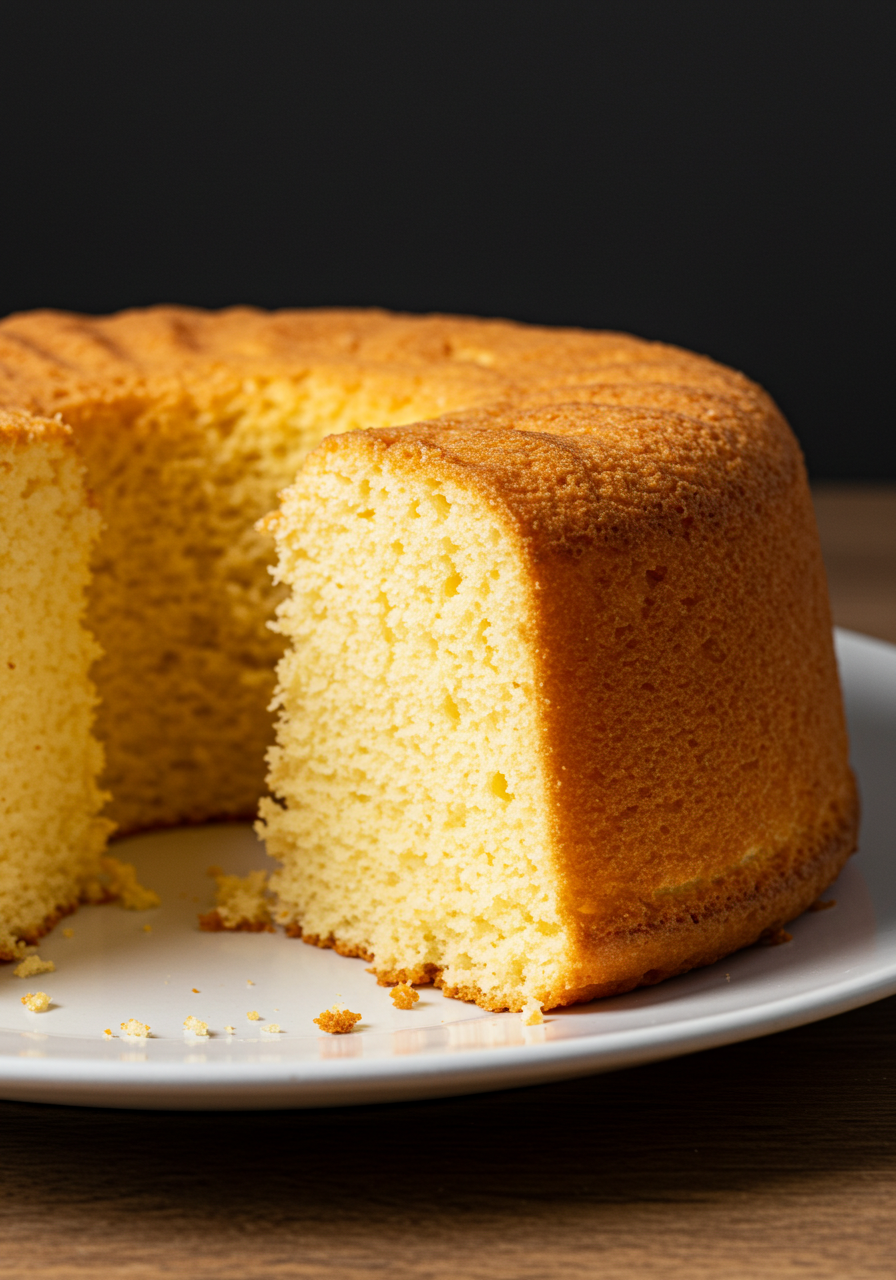Light, fluffy, and delicately sweet, Pão de Ló is a beloved traditional Portuguese sponge cake often served during Easter and festive holidays. With its airy texture and simple ingredients, this cake captures the essence of old-world baking. Whether enjoyed plain, dusted with powdered sugar, or served with fruit or whipped cream, Pão de Ló is a timeless dessert that’s both elegant and easy to make.
Love classic European cakes and pastries? Subscribe now and receive authentic, regional dessert recipes delivered straight to your inbox!
Why You’ll Love This Recipe
Old-World Tradition – A true Portuguese classic with centuries of history.
Light & Airy – Made with whipped eggs for a delicate sponge texture.
Minimal Ingredients – Just eggs, sugar, and flour—simple and pure.
Perfect for Celebrations – A symbolic Easter treat, but great year-round.
Naturally Dairy-Free – No butter or milk, just the richness of eggs.
Ingredients You’ll Need
For the Cake:
• 6 large eggs, room temperature
• 1 cup granulated sugar
• 1 cup all-purpose flour (sifted)
• 1 tsp lemon zest (optional, for flavor)
• 1 tsp vanilla extract (optional)
For Serving (Optional):
• Powdered sugar for dusting
• Fresh berries
• Whipped cream or fruit compote
Tools You’ll Need
• Electric mixer or stand mixer
• Mixing bowls
• Sifter
• Rubber spatula
• 8-inch or 9-inch round cake pan (springform or traditional)
• Parchment paper
Step-by-Step Instructions
Step 1: Preheat and Prepare the Pan
Preheat oven to 350°F (175°C).
Line the cake pan with parchment paper—allow it to hang over the sides for a rustic look (traditional method). Do not grease the pan.
Step 2: Beat the Eggs and Sugar
In a large mixing bowl, beat the eggs and sugar together on high speed for 8–10 minutes.
The mixture should become pale, thick, and triple in volume. This step is key to the cake’s airy texture.
Step 3: Add Flavorings (Optional)
Gently mix in the lemon zest and vanilla extract if using.
Step 4: Fold in the Flour
Sift the flour over the egg mixture in three batches.
Use a rubber spatula to gently fold in the flour each time, being careful not to deflate the batter.
Do not overmix—just enough to incorporate.
Step 5: Bake the Cake
Pour the batter into the prepared cake pan.
Tap the pan gently on the counter to release any large air bubbles.
Bake for 25–30 minutes, or until the top is golden and a toothpick inserted comes out mostly clean (a little moist in the center is okay for traditional texture).
Step 6: Cool and Serve
Let the cake cool in the pan for 10 minutes, then lift it out using the parchment edges.
Cool completely on a wire rack.
Dust with powdered sugar before serving, or pair with whipped cream and berries.
Tips for the Best Pão de Ló
Use Room Temperature Eggs – They whip better and create more volume.
Beat Eggs Thoroughly – This is where the cake gets its structure and rise.
Sift the Flour – Ensures lightness and prevents lumps.
Fold Gently – Retain the air bubbles for a tender, airy crumb.
Don’t Overbake – The center should remain slightly moist for traditional texture.
Serving Suggestions
• With strong espresso or Portuguese coffee
• Topped with citrus curd or berry jam
• Alongside a glass of Port or sweet dessert wine
• As part of an Easter dessert spread
• Layered with whipped cream and strawberries for a twist
How to Store & Freeze
Storing:
• Store at room temperature in an airtight container for up to 3 days.
• Refrigerate if using cream toppings, but consume within 2 days.
Freezing:
• Freeze slices individually wrapped in plastic and foil.
• Store in freezer for up to 1 month. Thaw at room temperature.
Frequently Asked Questions
1. Is Pão de Ló supposed to be dry or moist?
Traditional versions range from very dry and airy to slightly moist and gooey in the center. This recipe strikes a classic balance—light and soft with a hint of moisture.
2. Can I make it gluten-free?
Yes—use a 1:1 gluten-free flour blend. The texture may differ slightly but still works well.
3. What’s the difference between Pão de Ló and other sponge cakes?
Pão de Ló uses no butter or oil, focusing entirely on the volume of eggs for its light structure.
4. Can I make mini versions?
Absolutely—use muffin tins or mini cake pans. Bake for 12–15 minutes, depending on size.
5. Is it always served plain?
Traditionally, yes. But it’s commonly paired with fruit, cream, or dusted with powdered sugar during Easter celebrations.
Final Thoughts
Pão de Ló is more than just a cake—it’s a taste of Portuguese heritage, bringing old-world charm to modern-day tables. With its light, sponge-like texture and delicate flavor, it’s perfect for celebrating Easter, birthdays, or simply enjoying with a cup of tea. Whether served plain or dressed up with fruit and cream, this cake is always a welcome treat.
Bake a piece of tradition and share the love! Don’t forget to tag your bakes and leave a review!
Preparation Time: 15 minutes
Baking Time: 30 minutes
Cuisine: Portuguese / European
Nutritional Information (Per Slice – 1 of 10):
Calories: 140 | Protein: 4g | Carbohydrates: 22g | Fat: 3g | Sugar: 14g | Fiber: 0g | Sodium: 35mg

Portuguese Easter Cake (Pão de Ló)
- Total Time: 45 minutes
Description
Light, fluffy, and delicately sweet, Pão de Ló is a beloved traditional Portuguese sponge cake often served during Easter and festive holidays. With its airy texture and simple ingredients, this cake captures the essence of old-world baking. Whether enjoyed plain, dusted with powdered sugar, or served with fruit or whipped cream, Pão de Ló is a timeless dessert that’s both elegant and easy to make.
Love classic European cakes and pastries? Subscribe now and receive authentic, regional dessert recipes delivered straight to your inbox!
Ingredients
For the Cake:
• 6 large eggs, room temperature
• 1 cup granulated sugar
• 1 cup all-purpose flour (sifted)
• 1 tsp lemon zest (optional, for flavor)
• 1 tsp vanilla extract (optional)
For Serving (Optional):
• Powdered sugar for dusting
• Fresh berries
• Whipped cream or fruit compote
Instructions
Step 1: Preheat and Prepare the Pan
Preheat oven to 350°F (175°C).
Line the cake pan with parchment paper—allow it to hang over the sides for a rustic look (traditional method). Do not grease the pan.
Step 2: Beat the Eggs and Sugar
In a large mixing bowl, beat the eggs and sugar together on high speed for 8–10 minutes.
The mixture should become pale, thick, and triple in volume. This step is key to the cake’s airy texture.
Step 3: Add Flavorings (Optional)
Gently mix in the lemon zest and vanilla extract if using.
Step 4: Fold in the Flour
Sift the flour over the egg mixture in three batches.
Use a rubber spatula to gently fold in the flour each time, being careful not to deflate the batter.
Do not overmix—just enough to incorporate.
Step 5: Bake the Cake
Pour the batter into the prepared cake pan.
Tap the pan gently on the counter to release any large air bubbles.
Bake for 25–30 minutes, or until the top is golden and a toothpick inserted comes out mostly clean (a little moist in the center is okay for traditional texture).
Step 6: Cool and Serve
Let the cake cool in the pan for 10 minutes, then lift it out using the parchment edges.
Cool completely on a wire rack.
Dust with powdered sugar before serving, or pair with whipped cream and berries.
Notes
Use Room Temperature Eggs – They whip better and create more volume.
Beat Eggs Thoroughly – This is where the cake gets its structure and rise.
Sift the Flour – Ensures lightness and prevents lumps.
Fold Gently – Retain the air bubbles for a tender, airy crumb.
Don’t Overbake – The center should remain slightly moist for traditional texture.
- Prep Time: 15 minutes
- Cook Time: 30 minutes
- Cuisine: Portuguese / European



